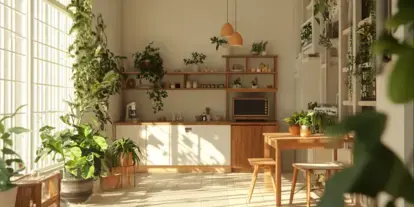
How to Detox Your Indoor Environment for a Healthier Home
Contact COIT for a professional cleaning!
When we think about detoxing, most of us imagine cleaning up our diets or spending more time outdoors. But have you considered that your indoor environment might need a detox, too?
From the air we breathe to the furniture we sit on, our homes can harbor toxins that negatively impact our health. At COIT, we believe in creating cleaner, healthier living spaces—and it all starts by removing hidden contaminants from your home.
Let’s look at the most effective ways to detox your indoor environment, room by room, with practical, actionable tips from our experts at COIT. And if you need a little extra help keeping your home safe, reach out to our team for professional deep cleaning services and restoration.
Step 1: Breathe Easy – Improving Indoor Air Quality
Indoor air pollution is a major concern because it’s easy to overlook.
With dust, allergens, and chemicals lingering in the air, you might be exposing yourself to harmful pollutants every day. The air inside our homes can be two to five times more contaminated than the air outside, according to the EPA.
So how do you start improving it?
Open those windows! It might sound simple, but allowing fresh air to circulate does wonders for reducing indoor pollutants. Make it a daily habit, even during colder months, to air out your home for a few minutes.
Air duct cleaning is another important step in maintaining healthy indoor air quality. Dust, dirt, and allergens can build up in your HVAC system over time, circulating through your home whenever the system is on. At COIT, we offer professional air duct cleaning services to remove these contaminants and ensure your system is running efficiently. Regular air duct cleaning can also help your HVAC system work more effectively, which saves you energy and actually extends its lifespan.
Speaking of HVAC systems, keeping your heating and cooling system well-maintained is key to reducing indoor pollutants. Change air filters regularly, ideally every three months, to prevent dust and debris from being recirculated through your home. If you're unsure about the best type of filter for your system, look into high-efficiency particulate air (HEPA) filters, which trap even the smallest particles like dust, pollen, and mold spores.
Lastly, don’t forget about your furniture. New couches, mattresses, and carpets often release chemicals like VOCs (volatile organic compounds) into the air, a process known as off-gassing. To combat this, try airing out new items in a well-ventilated area before moving them into your main living spaces.
Step 2: Clean Up Your Water
Water is life, but the water flowing through your taps might carry unwanted contaminants. Chlorine, pesticides, and heavy metals can easily find their way into your drinking water.
Here’s a tip: consider attaching a water filter to your faucet. This is super easy and can significantly reduce harmful chemicals like lead and chlorine in your water for cleaner, healthier water for drinking, cooking, and even bathing. Bottled water isn’t always the safer option, either. Chemicals in plastic bottles, like BPA, can leach into the water, especially if the bottle is exposed to heat.
At COIT, we recommend ditching single-use plastic bottles altogether. They’re bad for the environment and stainless steel or glass bottles are much better choices for long-term health. Plus, they reduce plastic waste—always a good move.
Step 3: Break Up with Plastic
Plastics might be convenient, but many contain chemicals that can disrupt hormones and impact long-term health. BPA and phthalates, which are found in many types of plastic, are common culprits.
So, what’s the first step to detoxing your home of plastic?
One simple change is swapping out plastic food storage containers for glass or stainless steel alternatives. These materials are more durable and safer when heated, as plastics can release harmful chemicals when exposed to heat.
The same goes for food preparation—stick with stainless steel or cast iron cookware instead of nonstick pans, which might contain toxic chemicals like PFAS
Try this: make a gradual shift by replacing one or two plastic items each month. Start with what you use most frequently, like food containers, and you’ll see how easy it is to reduce plastic in your home.
Step 4: Rethink Your Cleaning Routine
Your cleaning products might smell great, but lots of conventional cleaners contain chemicals that can harm your health. Synthetic fragrances, bleach, and ammonia are just a few of the toxins found in everyday products that can contribute to respiratory problems or skin irritation.
But there’s good news—natural cleaning alternatives are just as effective and a whole lot safer.
One of our favorite go-to solutions is good ole’ fashioned vinegar and baking soda. This dynamic duo can clean just about anything—from countertops to bathroom tiles—with zero harsh chemicals involved. Mix equal parts vinegar and water for an all-purpose cleaner that cuts through grease and grime, or sprinkle baking soda on stubborn stains before scrubbing with a damp cloth, and you’ve got a natural, affordable cleaning powerhouse.
If you’re looking for fragrance, skip the synthetic stuff. Instead, add a few drops of essential oils like tea tree or lavender to your homemade cleaning solutions for a fresh scent that doesn’t come with the health risks.
Step 5: Detox Your Bedroom
Since you spend about a third of your life sleeping, your bedroom deserves a little extra attention when detoxing your home. Mattresses, pillows, and bedding can contain flame retardants, formaldehyde, and other chemicals that off-gas harmful toxins into the air.
To detox your sleep environment:
- Opt for organic bedding. Look for mattresses and bedding that are made from natural materials like organic cotton or wool—these are usually free from synthetic chemicals and flame retardants.
- Wash your bedding regularly. Keep dust mites and allergens at bay by washing your sheets and pillowcases once a week and consider cleaning or replacing pillows every few months.
Don’t forget to air out your bedroom, especially after bringing in new furniture or bedding. Fresh air and regular cleaning can keep harmful chemicals from building up in your sleep space.
Step 6: Detox Your Kitchen – Cook and Store Food Safely
Your kitchen is where the magic happens, but it’s also the place where toxins can accumulate the quickest. From nonstick pans to plastic storage containers, everyday kitchen items can expose your food to chemicals like PFAS and BPA.
Consider upgrading to cast iron or stainless steel cookware. Not only do these materials last longer, but they also won’t leach harmful chemicals into your food when they’re heated. When it comes to storing leftovers, opt for glass or stainless steel containers over plastic.
Finally, keep an eye on the foods themselves. Processed foods are often wrapped in plastic and contain preservatives and other additives that aren't good for your body.
Stock your kitchen with whole, fresh foods whenever possible, and minimize plastic waste by buying in bulk and avoiding individually wrapped items.
Step 7: Keep Your Floors Clean
Floors can be a magnet for dust, dirt, and other contaminants, and carpets in particular can easily trap allergens and chemical residues. The key to a clean, healthy floor? Frequent cleaning and smart choices in materials.
- Vacuum regularly: Use a vacuum with a HEPA filter to suck up dust, dirt, and allergens from carpets and rugs. If you have hardwood or tile floors, a weekly sweep and mop with a natural cleaner (like a mix of vinegar and water) will keep them spotless without the use of harsh chemicals.
- Ditch the shoes at the door: This simple habit can make a big difference. Shoes track in dirt, pesticides, and other toxins from outside. Consider having a designated spot near the entrance for shoes to keep contaminants from spreading through your home.
Step 8: Safe Paint and Furniture Choices
If you’re planning to repaint or redecorate, be mindful of the materials you bring into your home. Lots of paints, finishes, and furniture contain VOCs that off-gas harmful chemicals into the air.
Look for low-VOC or zero-VOC paints when you’re doing any home improvement. These paints are designed to emit fewer harmful chemicals, making them a safer choice for indoor projects. The same goes for furniture—opt for items made from natural materials, like solid wood or metal, rather than particleboard or synthetic options.
A Cleaner, Healthier Home Awaits
Creating a healthier home environment doesn’t have to be complicated. Make a few small, intentional changes—like filtering your water, ditching plastics, and opting for natural cleaners—and before you know it, your space will feel fresher.
Ready to go even further? Let COIT handle the heavy lifting. Our expert cleaning services are designed to tackle the toughest contaminants, leaving your home cleaner and safer.
Contact us today to schedule a consultation!



